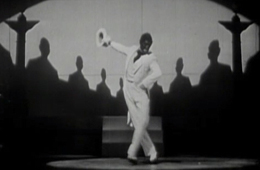Teachers' Domain - Digital Media for the Classroom and Professional Development
User: Preview

Source: The Rise and Fall of Jim Crow: “Promises Betrayed”
Thomas Dartmouth Rice, a struggling white actor from Manhattan’s Lower East Side, first appeared as “Jim Crow” in New York City's Park Theater in 1828. The exact details surrounding the creation of his “Jim Crow” character are difficult to confirm but one story is that Thomas Rice either modeled him after an elderly black male slave who had an ill-formed leg or a young black stable boy. Supposedly, Rice observed the man or boy singing a song that referred to “Jim Crow” where the singer punctuated each stanza with a little jump. Rice might have taken these lines from their song: ‘Weel about and turn about and do jis so, Eb'ry time I weel about I jump Jim Crow.’ Another possibility is that he may have been the original author of the same lines that appear on sheet music entitled “Jim Crow” and are credited to him.
To identify and define the character as black, Rice used burnt cork to darken his face. He also wore tattered clothes and sang and danced in a foolish, exaggerated way that demeaned black people while at the same time entertained white audiences. Rice’s style of performance was called “minstrelsy” or a “minstrel show.” In a short time, Rice’s minstrel show rose in popularity and achieved wide-spread success both within the United States as well as in England and Ireland. By the end of his life in 1860, he would be known as the “Father of American Minstrelsy.”
Countless minstrel acts followed Rice’s “Jim Crow” to include new characters such as “Dandies,” northern blacks who mimicked the dress and behavior of upper-class whites and by doing so, lived above their station in life. There was also the “Coon,” an inarticulate, lazy, black male adult who was easily frightened. Each character served to support negative, stereotypical ideas about African Americans as inherently inferior and accordingly unfit to live within American society with the same rights as white citizens. Soon, black minstrel performers followed the trend to mimic white performers mimicking blacks.
By 1838, the “Jim Crow” that began as a stock character in minstrel shows had become integral to American pop culture, making appearances in stage plays, advertisements, songs, novels and other popular amusements. By 1877, with the liberties provided by Reconstruction coming to a close, Jim Crow--an idea now entrenched in American society--became a term used to define the systematic and legalized apartheid under which black Americans often experienced brutal treatment with no protection or legal recourse. The Jim Crow system, used to justify thousands of lynchings, assaults, separate and unequal conditions, and an environment of constant intimidation, was challenged by African Americans and others but would not end until the Civil Rights movement in the mid-1960s.
SONG: First on de heel tap, den on the toe Every time I wheel about I jump Jim Crow
Wheel about, and turn about en do jus so.
And every time I wheel about, I jump Jim Crow....
Dressed in a patched and ragged coat, broken-down shoes and tattered straw hat, his face blackened, a black-mop wig on his head, he shuffles across the stage, singing as he moves. As he continues, the narrator resumes.
Narrator: In 1836, Jim Crow was born.
Narrator: He begins his strange career as a malicious minstrel caricature of a black man created by a white man to amuse white audiences. Jim Crow would come to symbolize one of the most tragic eras of race relations in American History. A time deeply-rooted in promise and contradiction. 1865. Four million Americans, slaves simply because they were born black were now free. But in a little over a decade that promise was gone, replaced by a rigid system of laws designed to keep blacks from experiencing any of their newly achieved rights. It would be known as the era of Jim Crow. The American form of racial apartheid.
 Loading Standards
Loading Standards